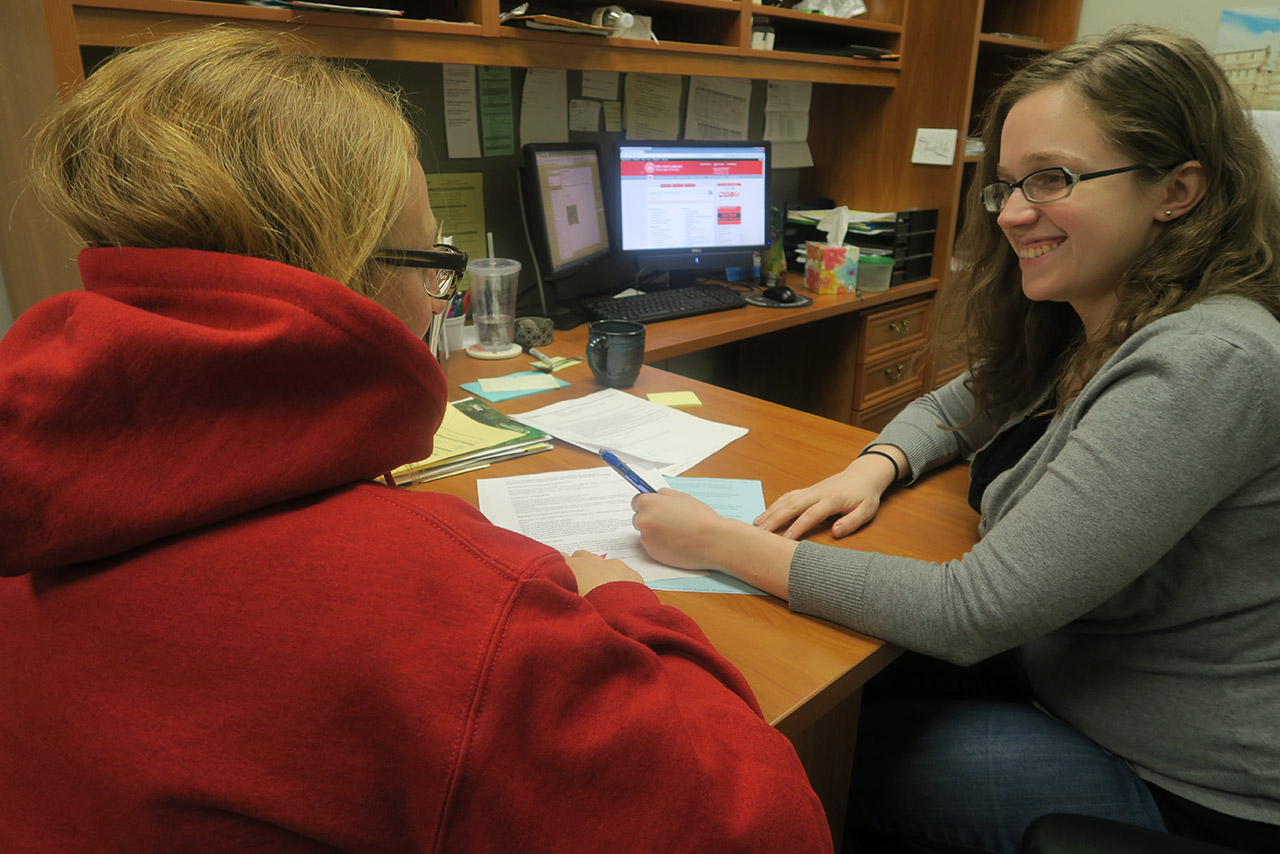We’re here to help. There are many ways that Milner Library helps students. Each semester, over 300,000 visits are made to Milner to meet groups or to study quietly. Plenty come for our study breaks with doughnuts and coffee during finals week each semester, and to pet therapy dogs every month. Students learn to go beyond a Google search with our databases. But there are more ways that Milner Library helps.
This is what Danielle Futoran, business librarian, has to say about how she helps individual students.
“A big part of my job is to help students find articles, statistics, data, or sources when they’re stuck on something,” Futoran said. “When I get a question from a student, I start by asking questions. With over a million books and dozens of databases in Milner, it’s important to get the topic as narrow as possible to find what you need. We’ve got three ways to search: our books, our article search, and our specialty databases (which most people don’t know about). Each one provides different types of information, so I check all three.
“A big part of my job is to help students find articles, statistics, data, or sources when they’re stuck on something.” —Danielle Futoran
“Sometimes, all three places to find information are needed,” Futoran said. “One student needed industry information for the U.S., Indian, and global markets for a high-level Management and Quantitative Methods (MQM) course. That’s a lot of information and it’s going to be tough to find all in one place, which is why he came to me. We had to use IBISWorld, several reference books, the OECD iLibrary, and the ‘Industry Report’ search in Business Source Complete to find everything he needed, but we did find it all.”
Nursing Librarian Sue Franzen also directly impacted student learning as an embedded librarian in an upper-level nursing class this past summer.
“In spring 2016, I met with Professor Jamie Penrod to discuss her summer class NUR 341: Leadership Dimensions in Nursing,” Franzen said.” The focus of our conversation was the three linked papers and a PowerPoint that comprised the students’ major assignment, an evidence-based change project. Together, we revised the paper guidelines and rubrics. In addition to creating a NUR 341 course guide, I wrote a sample annotated bibliography and synthesis on my own change project for students to model.
“The class was delivered online through Illinois State’s course management system, ReggieNet. When the class began, I introduced myself via ReggieNet’s message feature,” Franzen said. “During the semester, I sent additional messages about Milner resources, interlibrary loan, and APA. Soon, I started meeting with students to discuss a variety of topics, including primary/secondary sources, quality of evidence, searching strategies, and the annotated bibliography.
“Since the RN-to-BSN program is completely online, students had a choice to meet face-to-face, over the phone, or via Skype,” she said. “During a six-week period, I met with 35 students in over 40 individual meetings. After each meeting, I typed up notes and later sent them to Professor Penrod to use for assessments. Throughout the semester, Professor Penrod regularly told me students’ papers were stronger with my assistance as embedded librarian.”
Business Librarian Joe Zumalt also has implemented innovative teaching practices in his work with Business 100 classes.
“I started class with a short, three-question icebreaker that I distributed on a half sheet of paper about where the students might be getting business information,” Zumalt said. “It worked very well to increase classroom participation in some of the bigger classes. The icebreaker itself focused on where they commonly looked for business information and dovetailed nicely with my introduction of the five main business databases which were featured in their take-home assignment.
“I have also worked with students and faculty in other departments around the University,” Zumalt said. “In particular, I teamed up with a sociology professor, Michael Dougherty, to work with his SOC 330 students on commodity supply chain analysis, the professor’s field of expertise. There were individual consultations with several students that involved teachable moments. Early this summer, Professor Dougherty and I reconnected to discuss future projects for his course and his research.”
As Futoran said, “These are all example of how both faculty and students can get even more benefits from the library. Every student has a librarian assigned to their major who can help them just as much as I did. We can help you search for information, request books from other libraries in Illinois, help you with a tough citation question, or really anything research related.”

